|
THE CARTRIDGE COLLECTOR'S EXCHANGE |
| Contents
Cartridge
Lists Links to Other Sites
Cartridge Collectors Organizations:
Auctions:
Books:
Other Collectr's Sites: |
Home of the Old Ammo Guy's Virtual Cartridge
Trading Table
Picture Page
February 2004
This box of Winchester unheadstamped solid head .44-40 primed shells was
made sometime after 1880, when the company began producing solid head cases,
and before about 1884, when they began headstamping their centerfire rifle
and pistol cartridges. The solid head case resulted in a much stronger head
than its predecessor, the folded head case. Two of the cartridge cases
from this box are shown beside it in the picture above. I have also included
two sectioned cartridges to
illustrate
A rare cartridge that could be hiding in your collection.....
This rimfire can easily be mis-identified (more on this below), which could result in its being priced or traded at about 1/20th of its collector value. This is the rare .54 (or .56) Starr cartridge, made for use in the first 3000 of 5,000 Starr cartridge carbines that were produced for the U.S. Government towards the end of the Civil War. Basing an identification solely on the dimensions of the cartridge case would most likely lead one to believe it is the .56-52 Spencer. The two tool marks on the head of this cartridge suggest that it was made by C.D. Leet or Forehand & Wadsworth. However, its the characteristics of the Starr bullet employed by Leet in producing this cartridge that set it apart from its more common cousins. These include the relatively short, triangular shape of the bullet, with its sharp point, the sides of the bullet which start their curve towards the point just outside of the case mouth, and the two shallow, narrow grease grooves. The two tool marks on the head are also characteristic of Leet cartridges. The rest of the story: A long time collector with far more knowledge than I have has pointed out to me that the Starr carbine was never chambered for any cartridge other than the 56-50 Spencer. The cartridge above was identified as the .54 Starr by Berk Lewis, and was accepted as such by the cartridge collectors, perhaps for want of anything better. Apparently, it has recently been identified in Ballard, The Great American Single Shot Rifle by John Dutcher and Round Ball to Rimfire by Dean Thomas as the .52 Sharps and Hankins second model, produced by C.D. Leet. Who knows where the story about the first Starr carbines being chambered for a different cartridge came from, but it seems to have been accepted as fact by collectors and writers alike. Any comments regarding this subject would be greatly appreciated.
They'll shoot all right, but resizing must be a bear......
Here's a great box of 40-85-370 Ballard cartridges, intended for use in the Ballard Model 5 Pacific rifle or the Model 7 Long Range rifle. This box was made between about 1885 and 1900; the headstamped is U.M.C. S H .40-85. What intrigues me about this box is that the label indicates the cartridges are 'adapted to Ballard Rifle, using 40-85 Everlasting shells, yet the cartridge cases in the box aren't the thick walled Everlasting style. The .40-85 (or .45-90) Everlasting shell has a case mouth diameter of around .450"; while that of the standard shell is around .425". The bullet, base, and rim of the two shells are essentially the same, so while the standard .40-85 Ballard can be fired in a rifle chambered for the .40-85 Everlasting shell, the shell wall will expand nearly its full length to conform to the Everlasting chamber, resulting in the possibility of split cases or, at the very least, more elbow grease needed to resize the fired cases and, consequently, shortened case life. Or, perhaps I've missed something here.
An assortment of Kropatschek headstamps......
I recently purchased a number of sealed boxes of 8 x 56R Portugese Kropatschek
cartridges. The boxes had a mix of nine different headstamps, as shown in
the lower picture. The boxes are dated 1907, and the headstamps range from
1900 through 1907. I'm unable to decipher the rather generic labels, so I
can't say where these were boxed, but based on the mix of headstamps, I'm
assuming these are either reloads or they were repackaged.
|

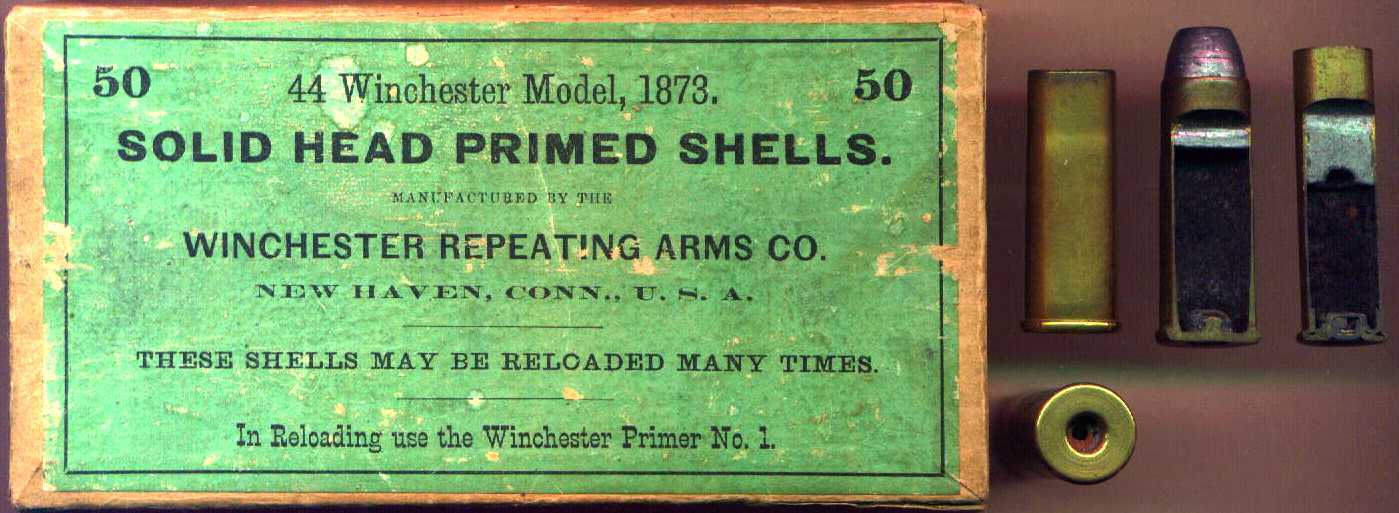
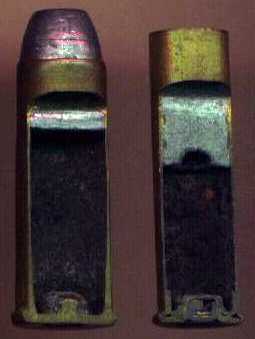 these two case styles. The cartridge on the right, a .38-44 Smith & Wesson,
has a folded head, constructed in the same manner as a rimfire case, but
with the addition of a brass reinforcing cup. The reinforcing cup is a donut
shaped piece that slipps down around the primer pocket and acts as a gas
seal between the primer pocket and the case wall to prevent the thin rim
from blowing out when the cartridge is fired. The reinforcing cup is readily
apparent in the enlarged picture as the 'U' shaped pieces on either side
of the primer pocket. Due to the inherent weakness of their heads, these
folded head cases could not be reloaded many times; in fact, the manufacturers
often advised against reloading them. The cartridge case on the left, a .44-40
like those in the box, has a solid head with a balloon primer pocket. This
style case eliminated the weaknesses of the folded head, producing a case
that could be reloaded many times, a fact which Winchester pointed out
on the label above. But even these cases would prove to be inadequate following
the development of smokeless powders and magnum loads. Modern cartridge cases
no longer have the balloon primer pocket with the open area around the primer
pocket; instead they are cast with a thick head, into which the primer
pocket and flash holes are drilled.
these two case styles. The cartridge on the right, a .38-44 Smith & Wesson,
has a folded head, constructed in the same manner as a rimfire case, but
with the addition of a brass reinforcing cup. The reinforcing cup is a donut
shaped piece that slipps down around the primer pocket and acts as a gas
seal between the primer pocket and the case wall to prevent the thin rim
from blowing out when the cartridge is fired. The reinforcing cup is readily
apparent in the enlarged picture as the 'U' shaped pieces on either side
of the primer pocket. Due to the inherent weakness of their heads, these
folded head cases could not be reloaded many times; in fact, the manufacturers
often advised against reloading them. The cartridge case on the left, a .44-40
like those in the box, has a solid head with a balloon primer pocket. This
style case eliminated the weaknesses of the folded head, producing a case
that could be reloaded many times, a fact which Winchester pointed out
on the label above. But even these cases would prove to be inadequate following
the development of smokeless powders and magnum loads. Modern cartridge cases
no longer have the balloon primer pocket with the open area around the primer
pocket; instead they are cast with a thick head, into which the primer
pocket and flash holes are drilled.
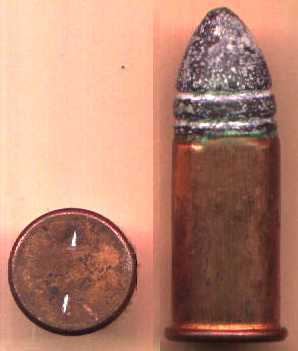
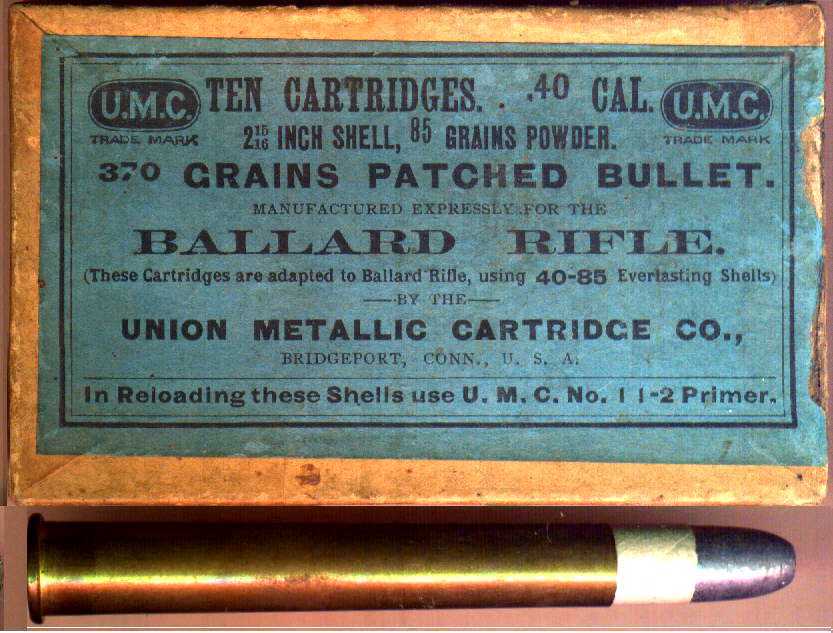
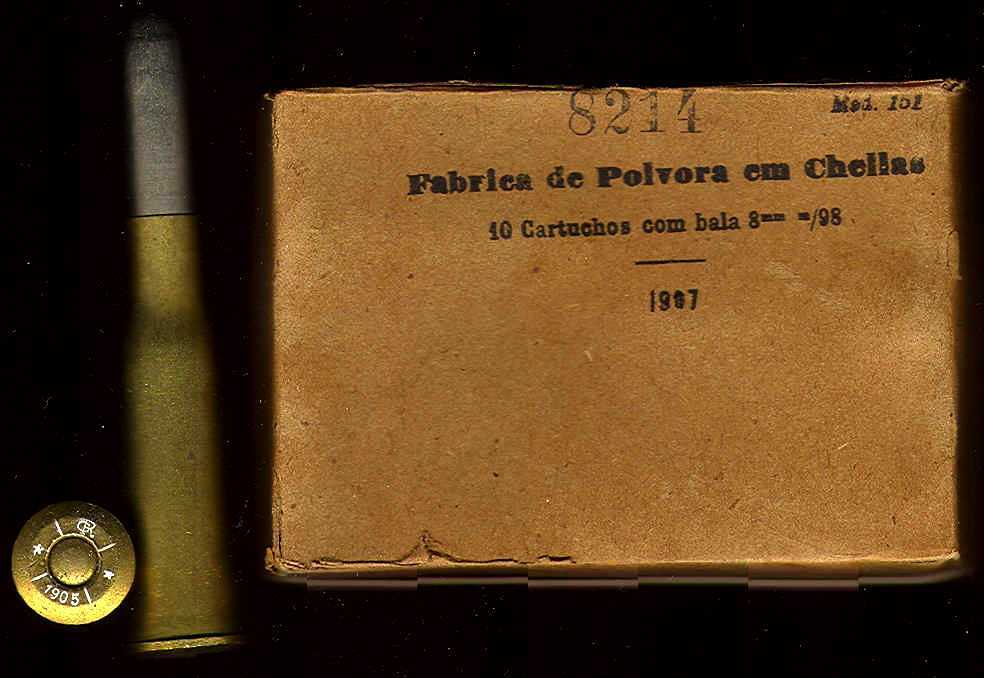
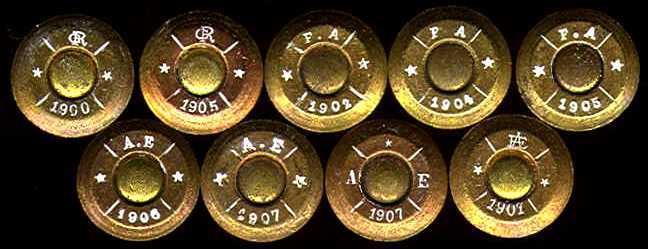 The
headstamps, beginning from the top left, identify the first two cartridges
as having been made by G. Roth of Vienna Austria in1900 and 1905, followed
by three by a maker I am not familiar with (F.A), made in 1902, 1904,
and 1905). The bottom four were produced by the Arsenal do Ejercito in Lisbon
Portugal in 1906 and 1907. It is interesting to note that three different
headstamp formats were used by this maker in 1907.
The
headstamps, beginning from the top left, identify the first two cartridges
as having been made by G. Roth of Vienna Austria in1900 and 1905, followed
by three by a maker I am not familiar with (F.A), made in 1902, 1904,
and 1905). The bottom four were produced by the Arsenal do Ejercito in Lisbon
Portugal in 1906 and 1907. It is interesting to note that three different
headstamp formats were used by this maker in 1907.